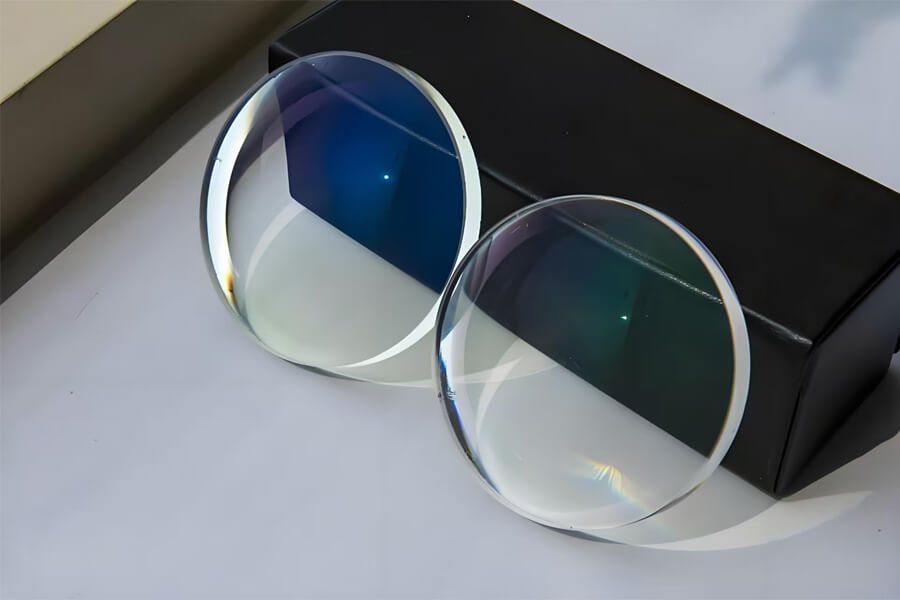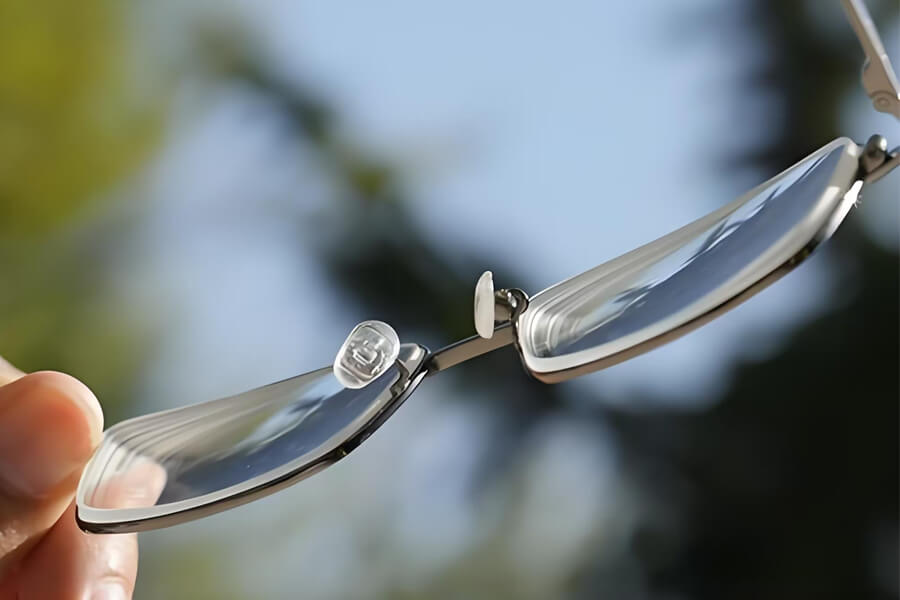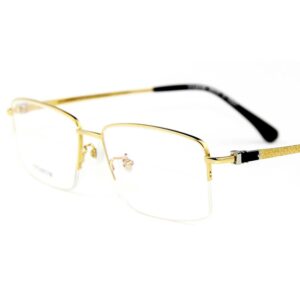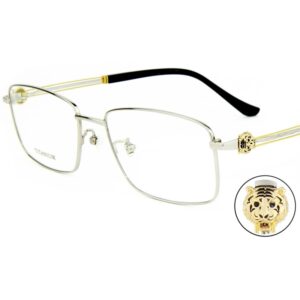In 2024, the world of optical lenses is more advanced and complex than ever before. For eyewear professionals, including wholesalers, custom manufacturers, and retail store owners, keeping up with the latest developments is essential. The choices you make regarding optical lenses can have a profound impact on your business. Whether you are selecting lenses for a bulk order or customizing options for individual clients, understanding the nuances of these products is crucial.
However, with so many materials, coatings, and designs to choose from, the process can quickly become overwhelming. Making the wrong choice can lead to dissatisfied customers, lost sales, and even damage to your brand’s reputation. This comprehensive guide aims to provide you with the knowledge you need to navigate the world of optical lenses with confidence, ensuring that your business can thrive in this competitive industry.
2. What Are Optical Lenses?
Optical lenses are the heart of any eyewear product, serving the primary function of correcting vision or protecting the eyes from harmful light. They are typically made from materials that can refract light in a way that corrects visual impairments such as myopia, hyperopia, astigmatism, or presbyopia. The right lens can significantly improve the wearer’s quality of life, enhancing their vision and providing comfort.
Optical lenses are crucial components in eyeglasses, and their importance cannot be overstated. The lenses not only correct vision but also offer protection from environmental factors like UV rays and blue light. In the competitive eyewear market, the quality and suitability of the lenses you offer will directly influence customer satisfaction and loyalty.
There are several types of optical lenses available, each serving different purposes:
- Single Vision Lenses: These lenses have the same focal power throughout and are typically used to correct nearsightedness, farsightedness, or astigmatism.

- Bifocal Lenses: Bifocals have two distinct areas for viewing, typically for distance and near vision, catering to individuals who need help seeing both up close and far away.

- Trifocal Lenses: Similar to bifocals, but with an additional segment for intermediate vision.

- Progressive Lenses: These lenses offer a gradual transition between different focal points without the visible lines of bifocals or trifocals, providing a more natural visual experience.

- Prism Lenses: Used to correct eye alignment issues, prism lenses bend light before it enters the eye, helping to manage conditions such as double vision or binocular vision disorders.

Understanding the different types of lenses and their applications is the first step in selecting the right product for your customers.
3. Key Features to Consider When Selecting Optical Lenses
When choosing optical lenses, there are several critical features to consider. These factors will determine the functionality, comfort, and durability of the lenses, as well as their suitability for different customer needs.
Material Options
The material of the lens plays a crucial role in its performance. Here are some of the most common materials used in optical lenses:
| Lens Material | Index of Refraction | Abbe Value | Key Benefits | Ideal For |
| Glass | 1.52 | 59 | High optical clarity, scratch resistance | High prescriptions needing clear vision |
| Plastic (CR-39) | 1.50 | 58 | Lightweight, good clarity, cost-effective | General use, low to moderate prescriptions |
| Polycarbonate | 1.58 | 30 | Impact-resistant, lightweight | Sports glasses, children’s eyewear, safety glasses |
| High-Index Plastic | 1.67 – 1.74 | 32 – 42 | Thinner, lighter, good for strong prescriptions | High prescriptions requiring thinner lenses |
Each material has its advantages and disadvantages, and the choice often depends on the specific needs of the wearer, including prescription strength, lifestyle, and personal preferences.
Index of Refraction and Abbe Value: Understanding Lens Performance
When selecting lens materials, two critical optical properties to consider are the index of refraction and the Abbe value. These factors play a significant role in determining the visual performance of lenses, including their thickness, weight, and clarity.
| Property | Description |
| Index of Refraction | Measures how much a material bends light. Higher values mean thinner, lighter lenses. |
| Abbe Value | Indicates the degree of chromatic aberration. Higher values mean less color distortion and better clarity. |
- Higher Refractive Index: Lenses with a higher index of refraction can correct vision with thinner and lighter lenses. This is particularly beneficial for individuals with strong prescriptions, as it reduces the bulkiness of their glasses.
- Higher Abbe Value: A higher Abbe value (above 40) indicates better optical clarity and less chromatic aberration, resulting in sharper vision.
Understanding the relationship between the index of refraction and Abbe value is essential for choosing the right lens material. For customers with strong prescriptions, high-index lenses may be preferred for their thinness, but it’s also crucial to consider the potential trade-off in visual clarity due to lower Abbe values.
Prism Lenses: Correcting Eye Alignment Issues
Prism lenses are specialized lenses designed to correct eye alignment problems, such as strabismus (crossed eyes) or diplopia (double vision). Unlike regular lenses, prism lenses do not correct refractive errors like myopia or hyperopia. Instead, they are used to adjust the way light enters the eyes, helping the eyes work together more effectively.
How Prism Lenses Work:
- Prism lenses bend light before it enters the eye, which can help to reposition images on the retina, allowing for better alignment and reducing double vision.
- The amount of prism needed is measured in prism diopters, and the direction of the prism (base in, out, up, or down) depends on the specific alignment issue being corrected.

Applications of Prism Lenses:
- Strabismus: Prism lenses help correct the eye alignment, reducing the effort required to align the eyes correctly.
- Diplopia: By adjusting the direction of light entering the eyes, prism lenses can help alleviate double vision, improving visual comfort.
Prism lenses are often prescribed by eye care professionals after a comprehensive eye exam. They are customized to the individual’s specific needs, making them an essential tool for managing complex vision issues.
Correcting Astigmatism: A Focus on Toric Lenses
Astigmatism is a common refractive error that occurs when the cornea or lens of the eye has an irregular curvature, leading to distorted or blurred vision. Unlike myopia (nearsightedness) or hyperopia (farsightedness), where the eye has a uniform curvature, astigmatism results in the eye having different curvatures in different directions. This irregularity requires a more specialized lens design to correct vision effectively.
Toric Lenses: The most common solution for astigmatism is the use of toric lenses. Unlike standard spherical lenses, which have the same power in all directions, toric lenses have different powers in different meridians of the lens. This allows the lens to correct the uneven curvature of the cornea or lens, providing clear and sharp vision.

Key Differences Between Toric Lenses and Standard Lenses:
- Lens Shape: Toric lenses are shaped differently from standard lenses. While standard lenses are typically spherical, toric lenses have a more complex shape that resembles a section of a torus (a donut shape). This design allows for varying degrees of curvature to correct the specific distortions caused by astigmatism.
- Power Distribution: In toric lenses, the lens power varies across different meridians. This means that the lens has one power for the meridian that requires more correction (to address the astigmatism) and another for the meridian that requires less correction.
- Lens Orientation: Because toric lenses need to align with the specific orientation of the astigmatism, they are often weighted or designed to stay in a particular position on the eye. This ensures that the correct powers are aligned with the corresponding meridians of the eye, providing optimal vision correction.
Comparing Toric Lenses with Myopia (Nearsighted) Lenses
When comparing lenses designed to correct astigmatism (toric lenses) with those used to correct myopia (standard spherical lenses), there are several key differences:
| Comparison Aspect | Toric Lenses | Myopia (Nearsighted) Lenses |
| Lens Shape | More complex, varying curvature | Uniform curvature |
| Power Distribution | Varies across different meridians | Same power throughout |
| Customization | Highly customized for individual needs | Easier to prescribe, less customization required |
| Cost | Generally more expensive | More affordable |
| Visual Clarity | Corrects both astigmatism and refractive errors | Corrects nearsightedness only |
Understanding the specific needs of customers with astigmatism is crucial for eyewear professionals. Offering toric lenses that are accurately fitted and tailored to the individual’s unique eye shape can significantly improve their visual experience and satisfaction.
Lens Coatings: Enhancing Durability and Functionality
Lens coatings are essential for improving both the durability and functionality of optical lenses. They can significantly enhance the user experience by providing protection against scratches, reducing glare, and offering additional health benefits like UV protection. In 2024, with advances in lens technology, there are even more options available for eyewear professionals to consider. Here, we’ll explore some of the most important lens coatings, including both traditional and cutting-edge options.
1. Anti-Reflective (AR) Coating
Anti-reflective (AR) coating is one of the most popular lens enhancements. It works by reducing the amount of light that reflects off the surface of the lenses, which can be particularly distracting during night driving or when using digital screens. By minimizing reflections, AR coatings improve clarity and reduce eye strain, making it easier to see in various lighting conditions.

Key Benefits:
- Improved Clarity: Reduced reflections lead to clearer vision.
- Aesthetic Appeal: Lenses appear almost invisible, which can be particularly desirable for those who are conscious of their appearance.
- Eye Comfort: Reduces glare from screens and headlights, making it ideal for people who spend a lot of time in front of digital devices or driving at night.
2. Scratch-Resistant Coating
Scratch-resistant coatings are essential for protecting lenses from everyday wear and tear. While no lens is completely scratch-proof, these coatings make lenses much more resilient to scratches caused by dust, debris, or accidental drops. This is particularly important for children’s glasses, safety eyewear, and active individuals.

Key Benefits:
- Extended Lens Life: Lenses with this coating are more durable and less likely to need replacement.
- Cost-Effective: Reduces the need for frequent lens replacements, saving money over time.
- Better Aesthetics: Keeps lenses looking new and clear, enhancing visual appeal.
3. UV Protection Coating
UV protection coatings are crucial for safeguarding the eyes from the harmful effects of ultraviolet (UV) rays. Prolonged exposure to UV rays can lead to various eye conditions, including cataracts and macular degeneration. Lenses with UV protection block these harmful rays, providing essential protection for eye health.

Key Benefits:
- Eye Health Protection: Reduces the risk of UV-related eye diseases.
- All-Day Protection: Effective even on cloudy days when UV rays can still penetrate the atmosphere.
- Compatibility: Can be combined with other coatings, such as AR or photochromic coatings, for enhanced performance.
4. Blue Light Filter Coating
Blue light filter coatings have become increasingly popular as more people spend long hours in front of digital screens. This coating helps reduce the amount of blue light that reaches the eyes, which can cause eye strain, fatigue, and even disrupt sleep patterns by interfering with melatonin production.

Key Benefits:
- Reduces Eye Strain: Helps alleviate discomfort associated with prolonged screen time.
- Improves Sleep Quality: Minimizes the impact of blue light on sleep patterns, particularly for those who use screens in the evening.
- Protects Retinal Health: Reduces the risk of long-term retinal damage caused by excessive blue light exposure.
5. Anti-Fog Coating
Anti-fog coatings are particularly beneficial in environments where temperature changes cause lenses to fog up, such as moving from a cold outdoors into a warm indoor space. This coating is also useful for athletes, healthcare workers, and anyone who wears masks, as it prevents fogging, ensuring clear vision at all times.

Key Benefits:
- Clear Vision in Any Condition: Prevents the lens from fogging, ensuring continuous clear vision.
- Ideal for Active Lifestyles: Perfect for sports, outdoor activities, and environments where temperature fluctuations are common.
- Enhances Safety: Reduces the risk of accidents caused by impaired vision due to foggy lenses.
6. Mirror Coating
Mirror coatings add a reflective layer to the outside of lenses, reducing the amount of light entering the eyes. This is particularly useful for sunglasses, as it provides additional protection against bright light and glare. Mirror coatings also add an aesthetic element, making sunglasses a fashion statement.

Key Benefits:
- Reduces Light Exposure: Perfect for high-glare environments like beaches, snowfields, or when driving.
- Aesthetic Appeal: Available in various colors, mirror coatings can give sunglasses a stylish, trendy look.
- Enhanced Privacy: The reflective nature of the coating can obscure the wearer’s eyes, providing additional privacy.
7. Anti-Smudge/Anti-Oil Coating
Anti-smudge or anti-oil coatings are designed to repel oils, water, and fingerprints, making lenses easier to clean and maintain. These coatings are particularly beneficial for people who frequently adjust their glasses or work in environments where their lenses are likely to get dirty.

Key Benefits:
- Easy Maintenance: Lenses stay cleaner longer and are easier to wipe clean when they do get dirty.
- Enhanced Clarity: Keeps lenses free of smudges and streaks, ensuring optimal vision.
- Durability: Protects the lens surface from everyday contaminants, extending the life of the lens.
8. Photochromic Coating
Photochromic coatings allow lenses to automatically adjust their tint based on the amount of UV light exposure. These lenses darken when exposed to sunlight and return to clear indoors, providing the convenience of not having to switch between prescription glasses and sunglasses.

Key Benefits:
- Convenience: Eliminates the need for multiple pairs of glasses by combining the functionality of both clear and tinted lenses.
- Eye Protection: Provides consistent UV protection whether indoors or outdoors.
- Versatility: Suitable for a wide range of environments and lighting conditions.
9. Hydrophobic Coating
Hydrophobic coatings repel water, making lenses resistant to moisture and ideal for use in wet conditions. This coating ensures that water droplets roll off the lens surface, maintaining clear vision even in the rain or during water sports.

Key Benefits:
- Clear Vision in Wet Conditions: Ideal for outdoor activities where exposure to water or rain is common.
- Easy Cleaning: Reduces water spots and makes lenses easier to clean.
- Enhanced Durability: Protects lenses from water damage and prolongs their lifespan.
10. Anti-Static Coating
Anti-static coatings prevent the buildup of static electricity on the lens surface, which can attract dust and other particles. This is particularly useful in environments where dust is prevalent, as it keeps lenses cleaner for longer periods.

Key Benefits:
- Reduced Dust Attraction: Keeps lenses cleaner by repelling dust and debris.
- Long-Lasting Cleanliness: Extends the time between cleanings, ensuring lenses remain clear and free of obstructions.
- Improved Lens Lifespan: Reduces the need for frequent cleaning, which can wear down coatings over time.
11. High-Definition (HD) Coating
High-definition (HD) coatings are designed to enhance the clarity and sharpness of vision. These coatings reduce visual distortions and enhance contrast, providing a more vibrant and detailed view of the world. They are particularly beneficial for people with high prescriptions or those who require precise vision, such as photographers or drivers.

Key Benefits:
- Enhanced Clarity: Provides sharper, clearer vision by reducing distortions.
- Better Contrast: Improves the ability to see fine details, especially in low-light conditions.
- Ideal for High Prescriptions: Offers superior vision correction for people with strong prescriptions.
4. Advanced Optical Lens Technologies in 2024
As we move further into 2024, several cutting-edge technologies are revolutionizing the optical lens industry. Staying informed about these advancements will allow you to offer the latest products to your customers, keeping your business competitive.
Digital Surfacing Technology
Digital surfacing, also known as freeform technology, allows for the creation of highly customized lenses. This technology uses computer-controlled equipment to carve lenses with extreme precision, optimizing the lens for the wearer’s specific prescription and visual needs. Digital surfacing can produce lenses with sharper vision and reduced distortions, providing a superior visual experience.
Freeform Lenses
Freeform lenses represent the pinnacle of optical lens customization. Unlike traditional lenses, which have uniform curvature, freeform lenses can be tailored to the individual’s unique visual requirements. This results in lenses that offer sharper focus, improved peripheral vision, and greater comfort.
For eyewear professionals, offering freeform lenses can be a significant selling point, particularly for customers who demand the best possible vision correction and comfort.
Smart Lenses
Smart lenses are a groundbreaking innovation in the optical industry. These lenses can adjust their tint in response to changes in light, offer augmented reality (AR) overlays, or even monitor the wearer’s health by measuring intraocular pressure. While still emerging, smart lenses represent the future of eyewear, offering a blend of vision correction, protection, and technology.
High-Definition Lenses
High-definition lenses are designed to provide clearer and sharper vision than standard lenses. Using advanced digital manufacturing techniques, these lenses reduce aberrations and offer enhanced clarity, particularly in low-light conditions. They are ideal for customers who need high precision in their vision correction.
These advanced technologies can set your business apart, allowing you to offer cutting-edge products that cater to tech-savvy customers and those with specific visual needs.
5. The Benefits of Offering Customizable Lenses
In today’s competitive market, offering customizable lenses can be a key differentiator for your business. Customization allows you to meet the specific needs and preferences of your customers, providing them with a product that is tailored to their lifestyle and vision requirements.
Meeting Customer Preferences
Customization enables you to offer lenses that are specifically designed to meet the unique needs of each customer. Whether it’s a particular lens material, coating, or design, providing options ensures that customers can get exactly what they need. This level of personalization can significantly increase customer satisfaction and loyalty.
Enhancing User Comfort and Experience
Custom lenses can be tailored for optimal comfort. For instance, by choosing the right lens material and design, you can reduce the weight and thickness of the lenses, making them more comfortable to wear. Additionally, customizing the lens design can reduce visual distortions and enhance the wearer’s overall experience.
Increasing Business Profitability
Offering customizable options can also boost your profitability. Customized lenses often come with higher price points, allowing you to increase your margins. Moreover, customers who are satisfied with their personalized eyewear are more likely to return for future purchases and recommend your business to others.
By offering a range of customizable options, you can cater to a broader market and differentiate your business from competitors who only offer standard products.
6. Common Challenges in the Optical Lens Industry
Like any industry, the optical lens market faces several challenges. Being aware of these issues can help you navigate them effectively and ensure your business continues to thrive.
Quality Control
Maintaining consistent quality across all lens batches is crucial. Variations in production can lead to lenses that do not meet the required specifications, resulting in customer dissatisfaction. Implementing strict quality control measures is essential to ensure that every lens you sell is of the highest standard.
Working with reputable suppliers who adhere to rigorous quality control processes can help mitigate these risks. It’s also important to regularly inspect the products you receive to ensure they meet your standards.
Supplier Reliability
The reliability of your suppliers is another critical factor. Delays in production or shipping can disrupt your operations, leading to missed sales opportunities and dissatisfied customers. Partnering with suppliers who have a proven track record of timely delivery and consistent product quality is essential for maintaining smooth business operations.
Establishing strong relationships with your suppliers and communicating your expectations clearly can help ensure reliability and reduce the risk of supply chain disruptions.
Customer Education
Helping your customers understand the different options available to them is vital. Many customers may not be aware of the various lens materials, coatings, and designs available, and they may need guidance in choosing the right products for their needs. Providing clear and informative explanations can help customers make informed decisions and increase their satisfaction with their purchase.
This educational approach can also set your business apart from competitors, as customers will appreciate the personalized service and expertise you offer.
Logistics and Lead Time
Managing logistics and lead times is another challenge in the optical lens industry. Delays in receiving products from suppliers can impact your ability to fulfill orders promptly, leading to customer dissatisfaction. Efficient logistics management is essential to ensure that products are delivered on time and that your inventory levels are appropriately maintained.
Using technology to track orders and manage inventory can help streamline logistics and reduce the risk of delays. It’s also important to have contingency plans in place in case of unexpected disruptions.
7. How to Choose the Right Optical Lens Supplier for Your Business
Selecting the right supplier is one of the most important decisions you will make for your business. The supplier you choose will directly impact the quality of the products you offer, your ability to meet customer demands, and your overall profitability.
Key Criteria for Selecting a Supplier
When evaluating potential suppliers, consider the following criteria:
- Certification: Ensure that the supplier meets industry standards and holds relevant certifications. This indicates that they adhere to recognized quality and safety standards.
- Reputation: Look for suppliers with a strong reputation in the industry. Customer reviews, industry awards, and word-of-mouth recommendations can provide valuable insights into a supplier’s reliability and quality.
- Communication: Effective communication is essential for a successful partnership. Choose a supplier who is responsive and transparent in their communications, ensuring that you are kept informed about any potential issues or delays.
- Pricing: While cost is an important factor, it should not be the sole determinant. Consider the value offered by the supplier, including the quality of the products, the level of service provided, and any additional support offered.
Evaluating Production Capacity and Quality Control Processes
It’s important to assess a supplier’s production capacity to ensure they can meet your needs, particularly during peak seasons. Ask about their production processes and quality control measures to ensure that they can consistently deliver high-quality products.
Visiting the supplier’s facility, if possible, can provide valuable insights into their operations and give you confidence in their ability to meet your standards.
The Importance of After-Sales Service and Support
After-sales service is a crucial aspect of any supplier relationship. Choose a supplier who offers robust support, including assistance with product issues, returns, and warranty claims. A supplier who stands behind their products will provide you with peace of mind and help you maintain strong customer relationships.
8. Frequently Asked Questions (FAQs)
What’s the difference between aspheric and spherical lenses?
Aspheric lenses have a more complex surface profile than spherical lenses, which allows for a flatter lens that reduces optical distortions and provides a wider field of view. This makes them thinner, lighter, and more comfortable to wear, especially for those with strong prescriptions.
Are high-index lenses worth the investment?
High-index lenses are typically thinner and lighter than standard lenses, making them a good choice for individuals with strong prescriptions. They offer improved comfort and aesthetics, which can justify the higher cost for many customers.
How do photochromic lenses work?
Photochromic lenses contain special molecules that change structure when exposed to UV light, causing the lenses to darken. When the UV light is no longer present, the lenses return to their clear state. This makes them convenient for those who move frequently between indoor and outdoor environments.
What are the best lens materials for durability?
Polycarbonate and Trivex lenses are among the most durable, offering high impact resistance and making them ideal for children’s glasses, sports eyewear, and safety glasses. Both materials are also lightweight and provide excellent optical clarity.
Can lens coatings really make a difference?
Yes, lens coatings can significantly enhance the performance and durability of lenses. Anti-reflective coatings improve visual clarity, scratch-resistant coatings extend the lifespan of lenses, and UV protection coatings safeguard the wearer’s eye health. Investing in quality coatings can lead to greater customer satisfaction and fewer returns.
9. Conclusion
In 2024, the optical lens industry continues to evolve, offering new opportunities for eyewear professionals. By understanding the different types of lenses, the materials and coatings available, and the latest technological advancements, you can make informed decisions that will benefit your business and your customers. Whether you are a wholesaler, custom manufacturer, or retail store owner, the right choices in optical lenses will enhance your product offerings, improve customer satisfaction, and ultimately drive your success. Stay informed, choose wisely, and your business will thrive in this competitive market.
























